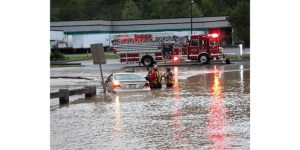Dalton Public Schools’ high school summer school at Morris Innovative finds ‘new normal’
Published 11:23 am Tuesday, July 7, 2020

- Ryan Anderson/Daily Citizen-NewsStaff members perform temperature checks and ask screening questions of students outside Morris Innovative High School on June 24 as the students arrive for summer school.
While distance learning remains a pivotal element, Dalton Public Schools’ summer school program for high school students is also being offered in-person, and enrollment has remained consistent with recent summers.
“Surprisingly, we’re right on our average,” said Russ Southerland, who has coordinated the summer school program the past handful of years. “We average about 150 kids,” and this year the number is only a few shy of that figure.
Trending
Most summer students are engaged in credit recovery — retaking a previously failed course — while “the others are ELL (English Language Learner) students taking classes to learn English,” and/or seniors “who can graduate if they just get another credit or two,” said Southerland, a teacher at Morris Innovative High School. Those in that final category “can just focus on that one class or two and get it done.”
Summer school is different this year due to the new coronavirus (COVID-19) pandemic, but “it’s interesting how we all adapt,” Southerland said. “Once you get used to that new routine, it becomes the new normal.”
Part of that new routine entails temperature checks and screening questions when students arrive in the morning before they enter Morris, he said. Every team of staff members performing those screenings has at least one Spanish speaker to make sure questions are relayed clearly to students and parents, because “you’re asking questions that are pretty important, (and) we’ve got the process down to about 30 seconds per student.”
Typically, summer school classes would be comprised of roughly 20 students, but now each classroom is down to a dozen to maintain social distancing measures, he said. In addition, students remain in their classrooms with their groups and teachers.
“It’s a good compromise to limit exposure, because we know who they are with when they’re here,” he said. “If a student were to test positive, we know who (he or she) has been in contact with.”
Furthermore, students come to school in shifts, with a Monday-and-Wednesday group and a Tuesday-and-Thursday contingent, he said. On “off” days, they do online learning. With the added online learning time, some students are accelerating their progress, he said. “The opportunity is there, and some are taking advantage of it.”
Trending
Previously, students had to leave their learning devices at school, but this year, due to all the online education, they can take them home, Southerland said. That’s meant an adjustment for teachers, as well, who have to put in more time working from home in addition to their time in school in order to be responsive to the students. Other items, such as the packs used for math classes that include calculators, “stay with students the entire time,” rather than being shared with classmates, he said.
The school day has been shortened to two hours, he said. In past years, the typical day was nearly four hours.
Staff members wear masks, and “we have a nurse who stays here with us all the time,” he said. Students have the option to wear masks.
Summer school at Morris began on June 1 and concludes on July 16. The school took off last week due to the July 4 holiday.
Gilberto Fraire has attended summer school multiple times, and he’s back again this year for credit recovery. He’s said he’s been productive during his home learning days, as well as at school with the smaller class sizes.
“Here, you can just (focus), do it, and there’s nothing to stop you,” Fraire said. “It’s good.”
Even with advances in digital education, “it’s important to have face-to-face interactions” at school, Southerland said. “Some students need to look at you when they have a question or watch a teacher demonstrate something — online doesn’t always work well.”
“It’s a delicate balance,” but students and staff “have adjusted to the new routines quite well,” Southerland concluded. “We’re making it work.”





